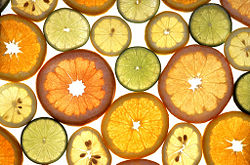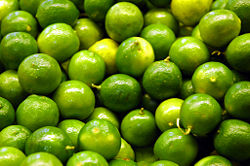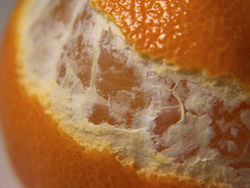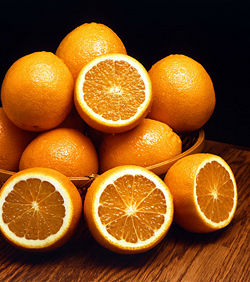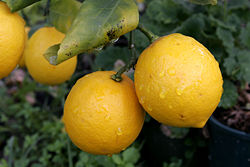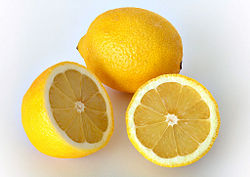Citrus
| Citrus | ||||||||||||||
|---|---|---|---|---|---|---|---|---|---|---|---|---|---|---|
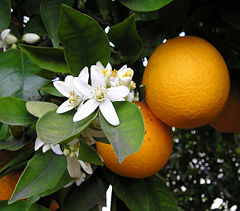 Citrus reticulata
| ||||||||||||||
| Scientific classification | ||||||||||||||
| ||||||||||||||
|
Species |
Citrus is a genus of flowering plants in the family Rutaceae (orange family) and a common name for edible fruits of this genus. Originating in tropical and subtropical southeast Asia, these plants are among the oldest fruit crops to be domesticated (Katz and Weaver 2003). Examples of citrus fruits include orange, lemon, lime, citron, grapefruit, kumquat, pomelo, and tangerine. Citrus is likely the most widely planted fruit for direct human consumption in the world (Katz and Weater 2003).
The taxonomy is complex. It is generally assumed that there were three fundamental citrus species and all others arose from hybridization events (Katz and Weaver 2003).
Citrus fruits are notable for their fragrance, partly due to flavonoids and limonoids (which in turn are terpenes) contained in the rind, and most are juice-laden. The juice contains a high quantity of citric acid giving them their characteristic sharp flavour. They are also good sources of vitamin C and flavonoids.
Characteristics
The plants are large shrubs or small trees, reaching 5–15 m tall, with spiny shoots and alternately arranged evergreen leaves with an entire margin. The flowers are solitary or in small corymbs, each flower 2–4 cm diameter, with five (rarely four) white petals and numerous stamens; they are often very strongly scented. The fruit is a hesperidium, a specialised berry, globose to elongated, 4–30 cm long and 4–20 cm diameter, with a leathery rind surrounding segments or "liths" filled with pulp vesicles. The genus is commercially important as many species are cultivated for their fruit, which is eaten fresh or pressed for juice.
prefer tropical to temperate climates native to Asia, but now found in many tropical to temperate climates, such as South America, Central America, southern North America,
Types and classification
The taxonomy of the genus is complex and the precise number of natural species is unclear, as many of the named species are clonally-propagated hybrids, and there is genetic evidence that even the wild, true-breeding species are of hybrid origin. Cultivated Citrus may be derived from as few as four ancestral species. Numerous natural and cultivated origin hybrids include commercially important fruit such as the orange, lemon, lime, grapefruit, and some tangerines. Recent research has suggested that the closely related genus Fortunella, and perhaps also Poncirus and the Australian genera Microcitrus and Eremocitrus, should be included in Citrus. In fact, most botanists now classify Microcitrus and Eremocitrus as part of the genus Citrus.
History
Prior to human cultivation, the genus Citrus originated in Southeast Asia and consisted of just a few species:
- Citrus maxima, the pummelo, from the Malay archipelago
- Citrus medica, the citron, from India
- Citrus aurantifolia, the key lime, from India
- Citrus reticulata, the mandarin and similar, from China
- Citrus halimii, a more recent discovery, from Thailand and Malaya
Cultivation
- Further information: Citrus production
As citrus trees hybridise very readily (e.g., seeds grown from Persian limes can produce fruit similar to grapefruit), all commercial citrus cultivation uses trees produced by grafting the desired fruiting cultivars onto rootstocks selected for disease resistance and hardiness.
The color of citrus fruits only develops in climates with a (diurnal) cool winter. In tropical regions with no winter, citrus fruits remain green until maturity, hence the tropical "green orange". The lime plant in particular is extremely sensitive to cool conditions, thus it is usually never exposed to cool enough conditions to develop a color. If they are left in a cool place over winter, the fruits will actually change to a yellow color. Many citrus fruits are picked while still green, and ripened while in transit to supermarkets.
Citrus trees are not generally frost hardy. Citrus reticulata tends to be the hardiest of the common Citrus species and can withstand short periods down to as cold as −10 °C, but realistically temperatures not falling below −2 °C are required for successful cultivation. A few hardy hybrids can withstand temperatures well below freezing, but do not produce quality fruit. A related plant, the Trifoliate orange (Poncirus trifoliata) can survive below −20 °C; its fruit are astringent and inedible unless cooked.
The trees do best in a consistently sunny, humid environment with fertile soil and adequate rainfall or irrigation. (Older 'abandoned' Citrus in low valleyland may suffer, yet survive, the dry summer of Central California Inner Coast Ranges. Any age Citrus grows well with infrequent irrigation in partial/understory shade, but the fruit crop is smaller.) Though broadleaved, they are evergreen and do not drop leaves except when stressed. The trees flower (sweet-scented at 2 to 20 meters) in the spring, and fruit is set shortly afterward. Fruit begins to ripen in fall or early winter months, depending on cultivar, and develops increasing sweetness afterward. Some cultivars of tangerines ripen by winter. Some, such as the grapefruit, may take up to eighteen months to ripen.
Major commercial citrus growing areas include southern China, the Mediterranean Basin (including Southern Spain), South Africa, Australia, the southernmost United States, and parts of South America. In the U.S., Florida, Texas, and California are major producers, while smaller plantings are present in other Sun Belt states.
Citrus trees grown in tubs and wintered under cover were a feature of Renaissance gardens, once glass-making technology enabled sufficient expanses of clear glass to be produced. The Orangerie at the Palace of the Louvre, 1617, inspired imitations that were not eclipsed until the development of the modern greenhouse in the 1840s. An orangery was a feature of royal and aristocratic residences through the 17th and 18th centuries. In the United States the earliest surviving orangery is at the Tayloe House, Mount Airy, Virginia.
Some modern hobbyists still grow dwarf citrus in containers or greenhouses in areas where it is too cold to grow it outdoors. Consistent climate, sufficient sunlight, and proper watering are crucial if the trees are to thrive and produce fruit. Compared to many "normal green" shrubs, citrus better-tolerates poor container care. For cooler winter areas, lime and lemon should not be grown, since they are more sensitive to winter cold than other citrus fruits. Lemons are commercially grown in cooler-summer/moderate-winter coastal Southern California, because sweetness is neither attained nor expected in retail lemon fruit. Tangerines, tangors and yuzu can be grown outside even in regions with sub-zero winters, although this may affect fruit quality. Hybrids with kumquats (citrofortunella) have good cold resistance.
Pests and diseases
Citrus plants are very liable to infestation by aphids, whitefly and scale insects (e.g. California red scale). Also rather important are the viral infections to which some of these ectoparasites serve as vectors such as the aphid-transmitted Citrus tristeza virus which when unchecked by proper methods of control is devastating to citrine plantations. The foliage is also used as a food plant by the larvae of some Lepidoptera species including Common Emerald, Double-striped Pug, Giant Leopard Moth, Hypercompe eridanus, Hypercompe icasia and Hypercompe indecisa. European brown snail (Helix) can be a problem in California, though laying female Mallard-based (Anas) ducks eat snails and slugs. .
Uses
Culinary
Many citrus fruits, such as oranges, tangerines, grapefruits, and clementines, are generally eaten fresh. They are typically peeled and can be easily split into segments. Grapefruit is more commonly halved and eaten out of the skin with a utensil. Orange and grapefruit juices are also very popular breakfast beverages. More astringent citrus, such as lemons and limes are generally not eaten on their own. Though 'Meyer' "Lemon" can be eaten 'out of hand', it is both sweet and sour. Lemonade or limeade are popular beverages prepared by diluting the juices of these fruits and adding sugar. Lemons and limes are also used as garnishes or in cooked dishes. Their juice is used as an ingredient in a variety of dishes, it can commonly be found in salad dressings and squeezed over cooked meat or vegetables. A variety of flavours can be derived from different parts and treatments of citrus fruits. The rind and oil of the fruit is generally very bitter, especially when cooked. The fruit pulp can vary from sweet and tart to extremely sour. Marmalade, a condiment derived from cooked orange and lemon, can be especially bitter. Lemon or lime is commonly used as a garnish for water, soft drinks, or cocktails. Citrus juices, rinds, or slices are used in a variety of mixed drinks. The skin of some citrus fruits, known as zest, is used as a spice in cooking. The zest of a citrus fruit, preferably lemon or an orange, can also be soaked in water in a coffee filter, and drank.
Medical
Citrus juice also has medical uses - the lemon juice is used to relieve the pain of bee stings. The orange is also used in Vitamin C pills, which prevents scurvy. Scurvy is caused by Vitamin C deficiency, and can be prevented by having 10 milligrams of Vitamin C a day. An early sign of scurvy is fatigue. If ignored, later symptoms are bleeding and brusing easily.
List of citrus fruits
- Alemow, Colo, C. ×macrophylla
- Amanatsu
- Bergamot orange C. ×bergamia
- Bitter orange, Seville Orange
- Blood orange
- Buddha's hand, C. medica
- Calamondin (Calamansi)
- Citron Citrus medica
- Clementine
- Daidai, Seville, Sour Orange, Citrus aurantium
- Dekopon- hybrid between ChungGyun mandarins and Ponkan
- Desert Lime, Citrus glauca (syn. Eremocitrus glauca)
- Djeruk limau, C. ×amblycarpa, Indonesia
- Finger Lime, Citrus australasica, (syn. Microcitrus australasica)
- Gajanimma, Carabao lime, C. ×pennivesiculata
- Grapefruit, C. ×paradisi
- Ichang Lemon Citrus ×ichangensis
- Imperial lemon Citrus limon × Citrus ×paradisi
- Iyokan
- Kabosu Citrus sphaerocarpa
- Kaffir lime Citrus ×hystrix
- Key lime Citrus aurantifolia
- Kinnow
- Khasi pepeda, C. ×latipes
- Kumquat - in the related genus Fortunella, not Citrus; forms hybrids with Citrus (see Citrofortunella)
- Lemon Citrus ×limon
- Lime Citrus aurantifolia
- limetta, Sweet Lemon C. ×limetta
- Limequat Citrus ×Fortunella hybrids
- Mandarin Lime C. ×limonia
- Mandarin Orange, Dancy
- Meyer Lemon
- Mikan
- Natsumikan, Japan, C. ×natsudaidai
- Orange Citrus sinensis
- Orangelo: Chironja
- Orangequat
- Oroblanco
- Persian lime, Tahiti lime Citrus ×latifolia
- Pomelo, Pummelo, Shaddock, Citrus grandis
- Ponderosa lemon
- Ponkan
- Rangpur, Lemanderin Citrus ×limonia
- Rough Lemon C. ×jambhiri
- Satsuma
- Shekwasha, Taiwan tangerine, Hirami lemon, C. ×depressa
- Sudachi
- Sunki, Suenkat, C. ×sunki
- Sweetie
- Sweet Lime, Sweet Lime, Central America, C. ×limettioides
- Tachibana Orange
- Tangelo: Minneola tangelo Ugli
- Tangerine Citrus reticulata
- Tangor C. ×nobilis
- Ugli fruit
- Yuzu C. ×junos
ReferencesISBN links support NWE through referral fees
- Freitas de Araújo, E., Paganucci de Queiroz, L., and Machado, M. A. 2003. What is Citrus? Taxonomic implications from a study of cp-DNA evolution in the tribe Citreae (Rutaceae subfamily Aurantioideae). Organisms Diversity & Evolution 3(1): 55-62 (abstract online here)
- Nicolosi, E., Z. N. Deng, A. Gentile, S. La Malfa, G. Continella, and E. Tribulato. 2000. Citrus phylogeny and genetic origin of important species as investigated by molecular markers. Theoretical and Applied Genetics 100(8): 1155 - 1166 (abstract online here).
- Sackman. Douglas Cazaux. Orange Empire: California and the Fruits of Eden (2005) comprehensive, multidimensional history of citrus industry in California
- Various authors (2002). in Giovanni Dugo and Angelo Di Giacomo, eds.: Citrus. Taylor & Francis. ISBN 0-415-28491-0.
- Calabrese, Francesco. "Origin and history".
- 2 Citrus fruits from Purdue University
- Citrus taxonomy (abstract)
- partial (Vols 1, 2, & Vol 5, Chap 5) online publ. of 1967-1989 (last revisions of each vol) "The Citrus Industry", University of California Board of Regents (UC Press). Full printed versions should be at your University library.
External links
- Citrus Research and Education Center of IFAS(largest citrus research center in world)
- Citrus (Mark Rieger, Professor of Horticulture, University of Georgia)
- Sorting Citrus names
- Fundecitrus - Fund for Citrus Plant Protection is an organization of citrus Brazilian producers and processors.
- Home Citrus Growers
Credits
New World Encyclopedia writers and editors rewrote and completed the Wikipedia article in accordance with New World Encyclopedia standards. This article abides by terms of the Creative Commons CC-by-sa 3.0 License (CC-by-sa), which may be used and disseminated with proper attribution. Credit is due under the terms of this license that can reference both the New World Encyclopedia contributors and the selfless volunteer contributors of the Wikimedia Foundation. To cite this article click here for a list of acceptable citing formats.The history of earlier contributions by wikipedians is accessible to researchers here:
The history of this article since it was imported to New World Encyclopedia:
Note: Some restrictions may apply to use of individual images which are separately licensed.

